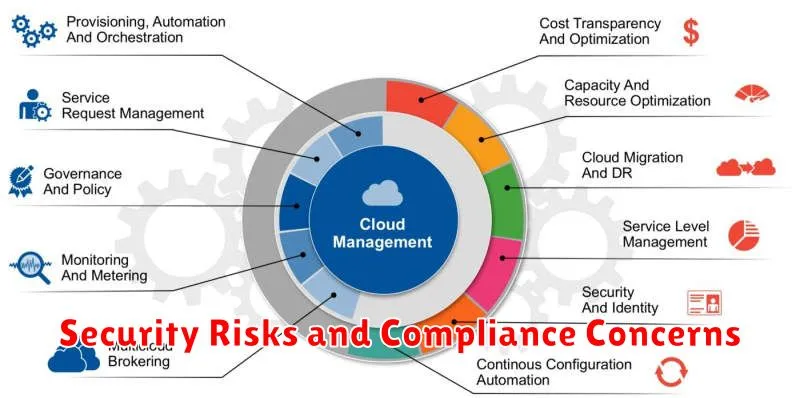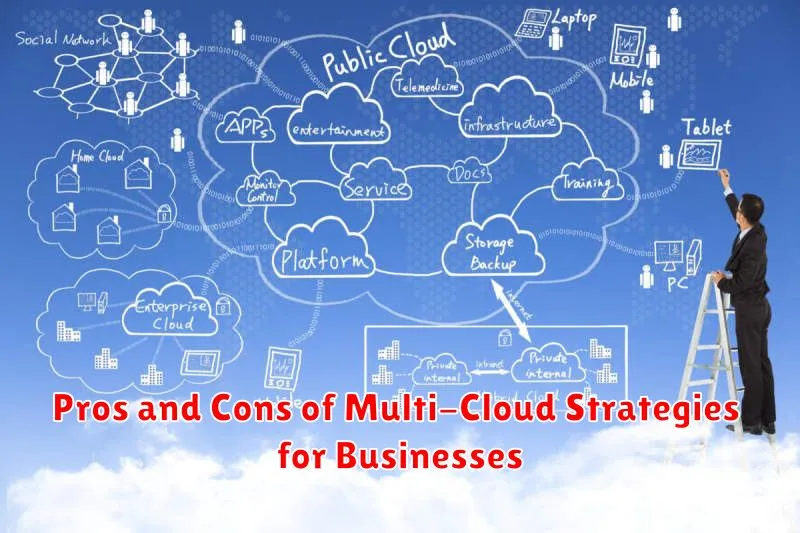In today’s rapidly evolving digital landscape, businesses are increasingly turning to multi-cloud strategies to enhance their IT infrastructure. A multi-cloud approach involves utilizing services from multiple cloud providers, as opposed to relying on a single vendor. This strategy offers a range of potential benefits, including increased flexibility, improved resilience, and the potential for cost optimization. However, managing a multi-cloud environment also presents significant challenges. Understanding the pros and cons of multi-cloud strategies is crucial for businesses looking to leverage the full potential of cloud computing while mitigating potential risks.
This article delves into the complexities of multi-cloud, examining the key advantages and disadvantages for businesses. We will explore the potential for enhanced scalability and performance that multi-cloud can offer, alongside the complexities of security management, vendor lock-in concerns, and the need for robust integration strategies. By understanding these factors, businesses can make informed decisions about whether a multi-cloud approach aligns with their specific needs and objectives. This comprehensive analysis will equip you with the knowledge necessary to navigate the multi-cloud landscape and determine the optimal strategy for your organization.
What Is a Multi-Cloud Strategy?
A multi-cloud strategy is the practice of using cloud services from more than one cloud provider. This can involve utilizing different providers for different workloads or combining services from multiple providers for a single application. Instead of relying solely on a single public cloud vendor, organizations strategically distribute their resources and applications across two or more cloud environments.
This approach differs from a hybrid cloud strategy, which typically combines on-premises infrastructure with one or more public cloud platforms. Multi-cloud focuses solely on using multiple public cloud providers. Businesses opt for a multi-cloud strategy for several reasons, including avoiding vendor lock-in, enhancing resilience, leveraging best-of-breed services, and optimizing costs.
By strategically distributing workloads, businesses can select the optimal cloud environment for specific tasks. For example, one provider might excel in data analytics while another offers superior security features. A multi-cloud strategy allows businesses to leverage these strengths and create a more robust and flexible IT infrastructure.
Advantages of Using Multiple Cloud Providers
Leveraging multiple cloud providers offers several key advantages. A primary benefit is avoiding vendor lock-in. By distributing workloads across different platforms, businesses reduce their dependence on a single vendor, fostering greater negotiating power and flexibility.
Increased resilience and disaster recovery capabilities are another significant advantage. If one provider experiences an outage, operations can continue uninterrupted on another platform, minimizing downtime and ensuring business continuity.
Multi-cloud strategies can also lead to optimized cost efficiency. Businesses can select the most cost-effective services from different providers for specific workloads, potentially reducing overall cloud spending.
Furthermore, using multiple cloud providers enables businesses to access specialized services and innovative technologies offered by different vendors. This allows for a best-of-breed approach, tailoring the cloud environment to specific business requirements.
Challenges in Management and Integration
Adopting a multi-cloud strategy presents significant management and integration challenges. Complexity is a primary concern, as managing multiple cloud providers requires specialized expertise for each platform. This involves navigating different APIs, security protocols, and billing models. Maintaining consistent security postures across diverse environments becomes more difficult, demanding robust security management practices.
Integration of applications and data across multiple clouds can be technically challenging. Ensuring seamless data flow and interoperability requires careful planning and the potential use of specialized integration tools. Furthermore, achieving consistent visibility across all cloud platforms for monitoring and performance management becomes essential for effective operations.
Cost optimization is also more complex in a multi-cloud environment. Organizations must carefully track spending across different providers and leverage cost optimization strategies specific to each platform. Vendor lock-in, while mitigated by using multiple providers, can still be a concern if applications are tightly coupled to specific cloud services.
Security Risks and Compliance Concerns

Adopting a multi-cloud strategy introduces inherent security risks and compliance challenges. Managing security across diverse environments becomes significantly more complex. Consistency in security policies and their enforcement is crucial but difficult to achieve across different cloud providers.
Data breaches pose a significant threat, especially when data resides across multiple clouds. Maintaining visibility and control over data access and movement becomes paramount. Each cloud provider has its own security protocols and tools, requiring specialized expertise and potentially leading to increased management overhead. Integration of security information and event management (SIEM) systems across multiple clouds can also be technically demanding.
Compliance with industry regulations and data sovereignty laws adds another layer of complexity. Organizations must ensure their multi-cloud strategy aligns with regulations like GDPR, HIPAA, and PCI DSS. Differing compliance requirements across various geographic locations and cloud providers require careful consideration and potentially necessitate tailored security configurations.
Cost Efficiency vs Complexity
While multi-cloud can offer potential cost savings by leveraging price variations between providers and avoiding vendor lock-in, it also introduces significant complexity. Managing multiple cloud environments requires specialized expertise and sophisticated tools. This can lead to increased operational overhead, negating potential cost benefits.
Cost optimization across multiple clouds demands careful planning and continuous monitoring. Factors like data transfer fees, differing pricing models, and the need for specialized security measures can contribute to unexpected expenses. Furthermore, the complexity of managing diverse environments can lead to higher staffing costs and the need for more advanced training.
Businesses must carefully weigh the potential cost advantages against the inherent complexities of a multi-cloud approach. A thorough cost-benefit analysis, considering both short-term and long-term implications, is crucial for determining the viability of a multi-cloud strategy.
Best Use Cases for Multi-Cloud
Leveraging multiple cloud providers can be a strategic advantage in specific scenarios. One compelling use case is disaster recovery. Distributing workloads across different cloud environments minimizes the impact of outages. If one provider experiences downtime, operations can seamlessly failover to another, ensuring business continuity.
Another key use case is optimizing for specific workloads. Different cloud providers excel in different areas. One might offer superior performance for machine learning applications, while another provides cost-effective storage solutions. A multi-cloud approach allows businesses to select the optimal environment for each workload, maximizing efficiency and performance.
Avoiding vendor lock-in is a significant driver for multi-cloud adoption. By distributing workloads across multiple providers, businesses retain greater control and flexibility. This reduces reliance on a single vendor and facilitates easier migration or negotiation of contracts.
Geopolitical considerations can also necessitate a multi-cloud strategy. Data sovereignty regulations often mandate that data be stored within specific geographic regions. A multi-cloud approach allows businesses to comply with these regulations by strategically placing data centers in compliant locations.
How to Get Started with a Multi-Cloud Setup

Embarking on a multi-cloud journey requires careful planning and execution. Begin by clearly defining your business objectives. What are you hoping to achieve with a multi-cloud strategy? Cost optimization, increased resilience, or accessing specialized services are common drivers.
Next, conduct a thorough assessment of your current IT infrastructure and applications. Identify dependencies and potential challenges in migrating to a multi-cloud environment. Understanding your existing setup is crucial for a smooth transition.
Once you have a clear understanding of your needs and current state, select your cloud providers strategically. Consider factors like geographic availability, service offerings, pricing models, and security compliance. Choosing the right providers is paramount for success.
Develop a proof-of-concept with a non-critical application. This allows you to test the waters and gain practical experience with managing a multi-cloud environment before a full-scale migration. This approach minimizes risk and provides valuable insights.
Finally, establish robust management and monitoring tools. Visibility across your multi-cloud setup is essential for maintaining control, optimizing performance, and ensuring security. Effective management is key to realizing the full potential of a multi-cloud strategy.

